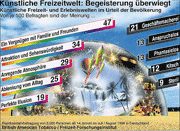Cathedrals of the 21st century
New study on theme parks and adventure worlds
At the dawn of the 21st century, a new race among theme parks has begun. The vote is being taken with their feet: film sets attract more visitors than real ruins. And Euro Disney draws more than twice as many visitors as the Louvre in Paris. Only about one in eight visitors (12%) sees these artificial leisure and adventure worlds as "kitsch productions," while almost four times as many (47%) find the visit genuinely enjoyable for the whole family and a shared experience with friends. This is according to a recent representative survey conducted by the Leisure Research Institute of British American Tobacco, in which 3,000 people aged 14 and over were asked about their perceptions and evaluations of theme parks and adventure worlds.
A new generation of TV and PC users is growing up, one that is perfectly comfortable living with artificial and virtual worlds. Every second young person aged 14 to 17 (50%) admires these artificial attractions as "tangible sights" and feels extremely comfortable in the "stimulating atmosphere." "The question often posed by cultural critics and experts, 'What do visitors actually want? Culture or scenery? Reality or illusion?' is wrongly posed," says institute director Prof. Dr. Horst W. Opaschowski. "Today's experience consumers want perfect illusions. And they are also satisfied with virtual worlds if they surpass reality." To this end, experiential worlds are conjured up, staged, and celebrated. Over 20 million Germans flock annually to the new cathedrals of the experience industry.
Leisure worlds, often referred to as "theme parks," are spreading worldwide. And the planning extends far beyond the turn of the century – from the "Millennium Dome" in London and the mega "Adventure City" (VW) in Wolfsburg to the "UFO" in Dortmund and the "Space Park" in Bremen. However varied public opinion may be regarding these artificial leisure and adventure worlds, the public's vote is relatively clear: for every critic, there are two enthusiastic visitors.
A representative survey conducted by the Leisure Research Institute of British American Tobacco reveals that one in four Germans (25%) praises the successful escape from everyday life, which can be found here like almost nowhere else. And roughly one in five respondents (19%) is positively enthralled by the perfect illusion: "You're enchanted and detached." Professor Opaschowski explains: "The visual engineers' calculations are working: The offered imagination is usually more impressive than reality. Visitors feel transported to a dream world that deliberately avoids any resemblance to the real one.""
On the other hand, visitors are also realists. 21 percent of those surveyed expose the offerings for what they are: "profiteering." The accusation of total commercialization is made particularly by respondents with higher education (lower secondary school graduates: 191,000; university graduates: 381,000). But even higher education doesn't deter most from enjoying themselves in such establishments. While one in six university graduates (171,000) criticizes visiting an amusement park as a form of "unimaginative leisure activity," more than twice as many (441,000) enjoy the family fun and the shared enjoyment with friends.
Dream grades for dream worlds
Whether it's a temple of consumption or an amusement park, a gaudy facade, a time-killer, or a trendy property: the clash of opinions hardly affects visitors' judgment and decisions. Top marks for dream worlds are the order of the day. Open-air events, from Michael Jackson to the Rolling Stones to the Three Tenors, receive a perfect score of "1.5," on a scale from 1 ("thrilled") to 5 ("disappointed"). Musicals (1.6), multiplex cinemas (1.7), water parks (1.8), and amusement parks (1.9) also receive good marks. Shopping centers (2.2) follow at a slight distance – from themed shopping arcades to urban entertainment centers (UECs), a blend of experiential retail, themed restaurants, and unique leisure attractions.
Different demographic groups place very different emphasis on various things: multiplex cinemas are rated highest by 14- to 17-year-olds, while open-air events are favored by young people aged 18 to 24. Childless couples are most enthusiastic about musicals. And retirees particularly appreciate shopping malls as diverse social hubs. Professor Opaschowski explains: "These new entertainment venues also serve as escape routes for people seeking respite from boredom and loneliness at home." Here, they also typically find what is increasingly lacking in many large cities and metropolitan areas: cleanliness, safety, and friendly staff.



